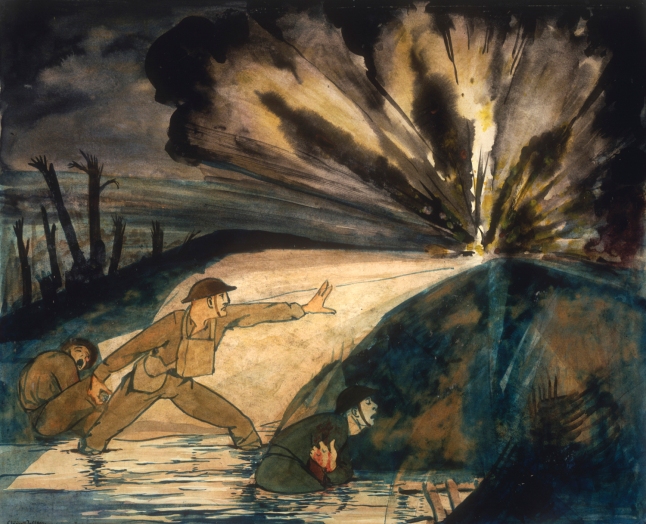Public Programs Explore Contemporary Cultural Connections and Role of Art in Healing Wounds of War, October 6, 2017–January 21, 2018
World War I and American Art was organized by the Pennsylvania Academy of the Fine Arts.
World War I and American Art, the first major exhibition to examine how American artists reacted to the First World War, opens at Nashville’s Frist Center for the Visual Arts on October 6, 2017. Works by more than seventy artists, including George Bellows, Marsden Hartley, Childe Hassam, Georgia O’Keeffe, Horace Pippin, and John Singer Sargent, represent a pivotal chapter in the history of American art that has until now been overlooked and underestimated.

James Montgomery Flagg (1877–1960). I Want YOU for U.S. Army, Nearest Recruiting Station, 1917. Poster, 40 x 29 1/2 in. Collection of Walton Rawls. Photo: The Library Company of Philadelphia
Timed to coincide with the centennial of the entry of the U.S. into the war, this ambitious exhibition organized by the Pennsylvania Academy of the Fine Arts (PAFA), Philadelphia, revisits a critical period in history through a wide variety of artistic responses, ranging from patriotic to dissenting. Garnering acclaim from outlets such as Forbes, The New York Times, and PBS NewsHour, the exhibition and its central themes of how artists respond to geopolitical turmoil is strikingly relevant today. American artists were vital to the culture of the war and the shaping of public opinion in several ways. Some developed propaganda posters promoting U.S. involvement, while others made daring anti-war drawings, paintings, and prints. Some worked as official war artists embedded with troops and others designed camouflage or took surveillance photographs.

James Montgomery Flagg (1877–1960). I Want YOU for U.S. Army, Nearest Recruiting Station, 1917. Poster, 40 x 29 1/2 in. Collection of Walton Rawls. Photo: The Library Company of Philadelphia
The exhibition features many high-profile loans from both private and public collections, including most importantly Sargent’s monumental tableau Gassed (Imperial War Museums, London), which has been seen in the U.S. only once before (in 1999).
“Working as an official war artist for the British government, Sargent witnessed the aftermath of a German mustard gas attack on British soldiers. He represented the harrowing scene on an epic canvas measuring about 7½ x 20 feet,” says Frist Center curator Trinita Kennedy. “Our presentation of the painting and the exhibition as a whole will be enriched by a lecture on opening day entitled ‘Mr. Sargent Goes to War’ by Richard Ormond, the artist’s great-nephew and a renowned scholar based in London.”

Claggett Wilson (1887–1952). Front Line Stuff, ca. 1919. Watercolor, pencil, and varnish on paperboard, 18 3/4 x 22 7/8 in. Smithsonian American Art Museum, Gift of Alice H. Rossin, 1981.163.11. Photo: Smithsonian American Art Museum, Washington, DC/Art Resource, NY
The organization of the exhibition mirrors the historical unfolding of the war itself. It begins by showing how American artists interpreted the threat of war while the U.S. remained neutral between 1914 and 1917, the debate to enter it, and then how the conflict involved them directly as soldiers, relief workers, political dissenters, and official artists. The spectrum of political points of view and purpose can be seen through the juxtaposition of works. Hassam’s flag paintings are impressionist and patriotic, while Hartley’s tribute paintings to his slain friend and possible lover, a German military officer, are abstract and mournful. Bellows, at first an opponent of the war, later encouraged US involvement by vilifying German war crimes with macabre detail. O’Keeffe’s more personal work reflected her conflicted feelings about her younger brother’s enlistment.

Marsden Hartley (1877–1943). Portrait, ca. 1914–15. Oil on canvas, 32 1/4 x 21 1/2 in. Lent by the Weisman Art Museum, Minneapolis, Bequest of Hudson D. Walker from the Ione and Hudson D. Walker Collection, 1978.21.234

George Bellows (1882–1925). The Return of the Useless, 1918. Oil on canvas, 59 x 66 in. Crystal Bridges Museum of American Art, Bentonville, Arkansas, 2009.6. Photo: Douglas Dalton. Reproduced with permission of The Bellows Trust
A group of patriotic artists came together to form the government’s first art agency in the service of war: the Division of Pictorial Publicity. On display will be iconic recruitment posters created by Laura Brey, Howard Chandler Christy, James Montgomery Flagg, and others that promoted enlistment with stirring imagery and language. There are also posters aimed at mobilizing women on the homefront, encouraging them to enter the workforce to support the war effort. As part of the Frist Center’s presentation, an education gallery with interactive electronic stations will allow visitors to explore such ideologically motivated works of art. Continue reading
